![]()
Drybrush – a watercolour technique explored by Andrew Wyeth
The American painter Andrew Wyeth divides his watercolours into plain watercolours and drybrush. He may start a painting as a watercolour, but during the process some of the paintings will change partly or fully to what he calls a drybrush. The drybrush technique is unique with a beautiful expression. It can be an inspiration for other watercolour painters as described in the following text.
Andrew Wyeth is a “storyteller”. A single painting has a story (and it can be a non-figurative painting, although it looks figuratively, because he paints his thoughts and feelings into the objects he apparently depicts). One painting may be considered as a small part of a large story. The painting: “Wood Stove” was made in the Olson house in Maine, where he has painted several hundred paintings and studies during the years, including the famous “Christina’s World”, owned by MOMA in New York.
Andrew Wyeth paints in both egg tempera and watercolour. His egg tempera technique is very detailed with rendering of tiny elements as for example the grass field in “Christina’s World”. It is the egg tempera technique, a technique where an initial wash is covered with the structure of woven dots and lines in different related or opposite colours, which is reflected in the watercolour drybrush technique.
In an interview Andrew Wyeth said to Thomas Hoving1: I work in drybrush when my emotion gets deep enough into a subject. So I paint with a smaller brush, dip it into color, splay the brush and bristles, squeeze out a good deal of the moisture and color with my fingers so there is only a very small amount of paint left. Then when I stroke the paper with the dried brush, it will make various distinct strokes at once, and I start to develop the forms of whatever object it is until they start to have real body…. Drybrush is layer upon layer. It is what you call a definite weaving process. You weave the layers of dry brush over and within the broad washes of watercolor. Andrew Wyeth’s curator Mary Landa has told that in some situations he use a special prepared brush with a tip which consists of down to one sable hair.
Meryman2 writes in general on Andrew Wyeth’s technique: Every watercolor has been like a battle, the outcome constantly in doubt. His breath fast, talking to himself, the glasses he wears paint-splattered with color, he attacks the paper with a frenzy, scratching it with the end of his brush, scraping it with a razor blade, dapping at it with Kleenex. Andrew Wyeth explains in an interview to the Greenville County Museum of Art3: I work with impulsiveness. I use eleven kinds of brushes, camel hair or sable or an old house painter's brush. Sometimes a scrub brush. I've torn pictures in half trying to get into them, to get structure and weight and form and succulence and passion.
The Farnsworth Art Museum in Rockland, Maine, is the owner of “Wood Stove”, a drybrush watercolour from the Olson house. The painting shows Christina Olson on the left in the kitchen and Alvaro Olson´s rocking chair (Christina’s brother) on the right in the painting. The painting is a mixture of different methods.
It is possible to talk at least about three levels in the painting:
- Wet-on-wet painting with the “accidents” that make the watercolour expressive and interesting.
- “Drawing” of figures and details with a small brush.
- Drybrush, with the aim of generating structure and a variety of colour expression.
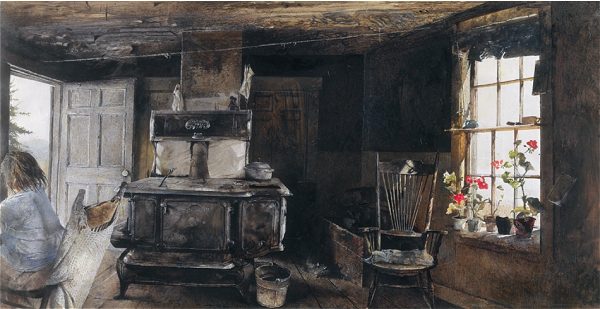
“Wood Stove”, 1962, drybrush on paper.
This painting was made in the Olson House in 1962.
35 x 68 cm. Farnsworth
Art Museum, © Andrew Wyeth
Different areas in “Wood Stove” can be clearly identified as wet-on-wet technique, where the accidents are important. Part of the ceiling, which has a dark structure from smoke and never has been painted by the Olsons, is made by a wet-on-wet technique. The front of the wood stove and the shade in the right window are also areas with wet-on-wet technique. Many of Wyeth’s watercolours have a strong expression from this effect, and it often gives a slight feeling of absence and distress. Especially the book from the exhibition at Whitney4 shows a number of examples.
The view through the window is painted in thin colour with high reflection from the paper, almost as a physical registration of the high lighting level from the outside.
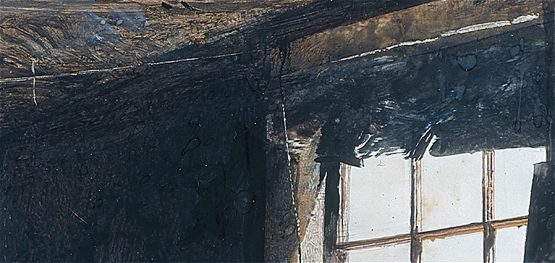
Ceiling and window blind with wet into
wet technique. Detail from “Wood Stove”.
Actual size of this section is 9 x
20 cm
The painting “Wood Stove” contains much painting with drybrush. This is shown in the rocking chair, in details of the wood stove, the window, the door, and in Christina’s hair. This technique is very basic. Andrew Wyeth received a book about Albrecht Dürer from his father when he was young, and this book was great inspiration for him. Paintings “Young Hare” and “The Great Piece of Turf” from 1502 and 1503 demonstrate the effect of drybrush painting made by Albrecht Dürer.
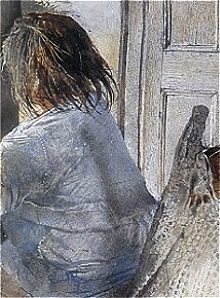
Detail in Drybrush from the painting: “Wood Stove”.
The back of Christina.
Actual size is 14 x 10 cm.
Drybrush is also used as a structure and a colour impression technique in several areas of “Wood Stove”. It is used in the door to give the impression of a weather-beaten and dry surface, which is actually facing the north side of the house. It is also used in the right side below the window, on the chimney and on the back of Christina as shown in the figure. The back is composed of tiny lines in several blue colours and earth-coloured grey. All in all a surface, which expresses a strong body, which is both in contrast and in harmony with the other elements in the Olson kitchen.
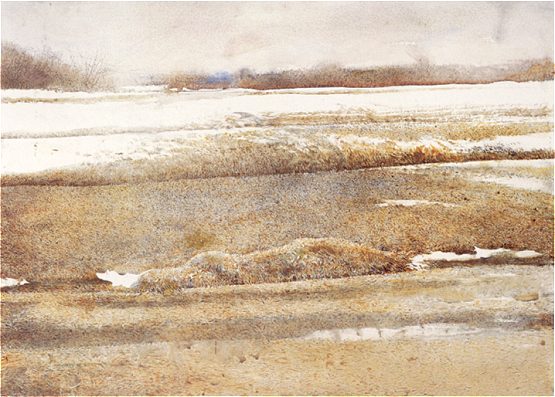
“Hoar Frost”, 1995, watercolour on paper. A
watercolour with areas of drybrush. 56 x 76 cm.
Private collection, © Andrew Wyeth.
“Wood Stove” was painted in 1962. “Hoar Frost” is a relatively new painting made in 1995. It shows the fields outside the artist’s home in Chadds Ford with wheel tracks made in the frozen ground. The painting is very suppressing in its expression, with a wonderful blue burst in the horizon. Large parts of the painting are made as a drybrush, and it is a good example of the use of drybrush to create surface and structure. The section shows how a weak blue and brown wash is covered by small lines in brown and blue to create the suggestion of a frozen surface. It is not the intention to depict the grass in details as pointed out by Venn4 but only to give a suggestion of the field. “Last Light” 1988 and “Cold Spring” 1988 are other examples of the use of drybrush for expression of a surface in different related colours.
It should be emphasized that it is necessary to study the actual paintings to enjoy the details in the drybrush technique. Books with watercolours can have a high quality but it is not possible to show the technique in a reduced scale, and it is not possible to express the texture of the surface in an acceptable way.
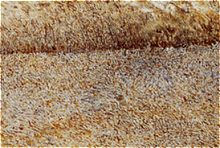
Drybrush detail from “Hoar Frost”.
The actual size of this section is 9 x 14 cm.
This text has discussed the different techniques in a very separating way, but it is important to realize that Andrew Wyeths interest in technique is only the question of whether or not it can express his feelings and need at a particular momet. The technique is always put in the service of visual experience, not of mere effect.
...and another story
It might be interesting for the readers to know that the Olson House can be visited. Alvaro and Christina Olson died in 1967 and 1968. The Olson House was on different hands, but it was donated to the Farnsworth Art Museum in Rockland in 1991, and is now a historic site preserved by the museum and the Wyeth Center. The photos show the kitchen and the wood stove in October 2002 photographed by the author.
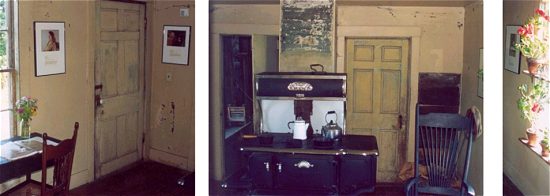
Photos from the kitchen in the Olson House. Christina’s chair is seen to the
left and Alvaro´s rocking chair is to the right. The furniture is a replica.
Literature
1 Thomas Hoving, Two Worlds of Andrew Wyeth: Kuerners and Olsons, The Metropolitan Museum of Art, 1976.
2 Richard Meryman, Andrew Wyeth: a secret life, HarperCollins Publishers, 1996.
3 Resource Library Magazine, http://www.tfaoi.com/aa/3aa/3aa295.htm
4 Beth Venn and Adam D. Weinberg, Unknown Terrain: The Landscapes of Andrew Wyeth, Whitney Museum of American Art, 1998.